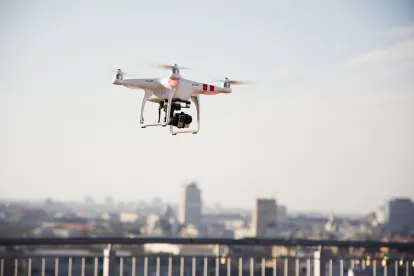The 2012 Federal Aviation Administration Modernization and Reform Act called for the Federal Aviation Administration (“FAA”) to institute a program to facilitate the safe integration of civil unmanned aircraft systems (“UAS”) into the National Airspace System (“NAS”) by September 30, 2015. While the legislatively imposed deadline passed with no regulatory program in place – and such a program is unlikely to be finalized until at least mid-2016 – 2015 has been a year for significant developments in UAS integration. FAA’s approvals under the Section 333 exemption process have skyrocketed, drafting of the final small UAS rule is wrapping up, the FAA recently proposed the largest penalty ever for the unauthorized operation of a UAS and announced the creation of a UAS Registration Task Force.
Section 333 Approvals Surpass 2,000
As we near the end of 2015, applying for a Section 333 exemption remains the primary process for companies to obtain the necessary FAA approval for commercial UAS operations. Back in January 2015, the FAA had approved less than 15 Section 333 petitions for exemption. By mid-November 2015, the Section 333 petitions granted have skyrocketed to just over 2,200. While UAS developers and the industries (primarily, the agricultural, real estate, energy, and film industry) seeking to capitalize on UAS technology would likely agree that the United States is still being outpaced by other countries when it comes to UAS integration, the progress being made by the FAA is worth noting.
The dramatic increase in Section 333 petitions being granted by the FAA can likely be attributed to the FAA’s summary grant process. Implemented mid-2015, under the summary grant process, the FAA looks to see if a new Section 333 petition request is similar to a previously approved petition request. If the new request is similar to a Section 333 petition that has been granted, the FAA will rely on its prior analysis and issue a summary grant. Another move by the FAA to integrate UAS quicker was the development of the “blanket” Certificate of Waiver or Authorization (“COA”) process.
In the past, once the FAA granted a Section 333 Exemption, the exemption holder would also have to file for a separate COA to fly the UAS in a particular block of airspace. The COA approval process can take 60 days. To cut down on that time, the FAA announced in March 2015 that companies with current Section 333 approvals and all future such approvals would be covered by a “blanket” COA as long as operations were at or below 200 feet. The “blanket” COA applies to any UAS operator that has been granted a Section 333 exemption for aircraft that weigh less than 55 pounds, that operate below 200 feet, during daytime Visual Flight Rules (“VFR”) conditions, within visual line of sight (“VLOS”) of the pilots, and that stay certain distances away from airports or heliports. UAS operations outside of these parameters still require the standard COA.
Small UAS Rulemaking Expected June 2016
Another major step-forward occurred in February 2015 with the release of the FAA’s Notice of Proposed Rulemaking focused on the Operation and Certification of Small UAS within the United States (“UAS NPRM”). With the UAS NRPM, the FAA proposed a comprehensive regulatory program applicable to “small” UAS, or those UAS weighing less than 55 pounds. Generally, the UAS NPRM covers UAS registration, UAS operating requirements, as well as UAS-operator requirements. The FAA has indicated it is in the process of wrapping up drafting of the final UAS rule. The next steps will include review by the Department of Transportation and other federal agencies. The FAA expects the final UAS rule to be released by June 2016.
Many industries, including the energy sector, have hopes that in the final UAS rule the FAA will make adjustments to some of the problem areas in the proposal, e.g., the requirement that operations be within the operators visual line-of-sight (VLOS), that operations not be performed over any persons not directly involved in the operation, and the restriction on night-time operations.
FAA Proposes Record Fine of $1.9 Million
Despite the dramatic expansion of UAS commercial operations over the past two years, it was not until early October 2015 that industry caught wind of a significant FAA UAS enforcement matter. On October 6, 2015, the FAA announced the largest civil penalty ever proposed against a UAS operator for allegedly operating a UAS “in a careless or reckless manner so as to endanger lives or property.” The proposed fine? $1.9 million. Not insignificant, and certainly an attention grabber for all UAS operators.
The specific allegations are that the UAS operator conducted 65 unauthorized commercial UAS flights over various locations in New York City and Chicago for the purpose of performing aerial photography. According to the FAA, 43 flights were performed in the New York Class B airspace without the proper air traffic control clearance. Additionally, the FAA alleged that the UAS was not equipped with a two-way radio, transponder, or altitude-reporting equipment. UAS operators will be closely watching the progression of this enforcement action to see the final penalty amount and the structure of any potential settlement.
UAS Registration Recommendations Due November 20, 2015
Reports of drones or UAS sightings in proximity to commercial aircraft are increasingly common. Additionally, UAS allegedly have interfered in fire suppression efforts during the recent California wildfires. To address these issue, on October 19, 2015, the DOT and FAA jointly announced the creation of a Unmanned Aircraft Systems Registration Taskforce. The UAS Registration Taskforce was created to advise the FAA on the small UAS that should be registered or exempt from registration due to a low safety risk, e.g., toys and certain other small UAS. The announcement of a registration requirement is not all that surprising considering that many UAS used for “recreational” purposes – and thus not required to proceed through the Section 333 process – are still capable of operations that can impact public safety. The UAS Registration Task Force met in Washington, D.C. on November 3-5, 2015. The Task Force’s recommendations are due to the FAA Administrator by November 20, 2015.
What to Expect in 2016?
In 2016, the Section 333 exemption process will remain the primary means of UAS integration. It will be interesting to see if the FAA grants Section 333 petitions with beyond-visual-line-of-sight (“BVLOS”) or night time operations. We will have to wait until mid-2016 (at least) for the final small UAS Rule. While there is some disappointment that a full UAS regulatory program was not in place by the September 30, 2015 deadline, the impact of knowing that the FAA has at least taken significant steps in 2015 towards UAS integration and plans to continue its momentum into 2016 should not be underestimated. The UAS industry in the United States now has at least some certainty. And with certainty comes investment, something all UAS stakeholders can be excited about. There is no question that the increased use of UAS will be transformative for many industries. At a very basic level, many sectors have already realized the safety and economic advantages of integrating UAS to replace or augment traditional practices. Additionally, companies have and will continue to discover new uses and opportunities as UAS technology advances.



 />i
/>i

